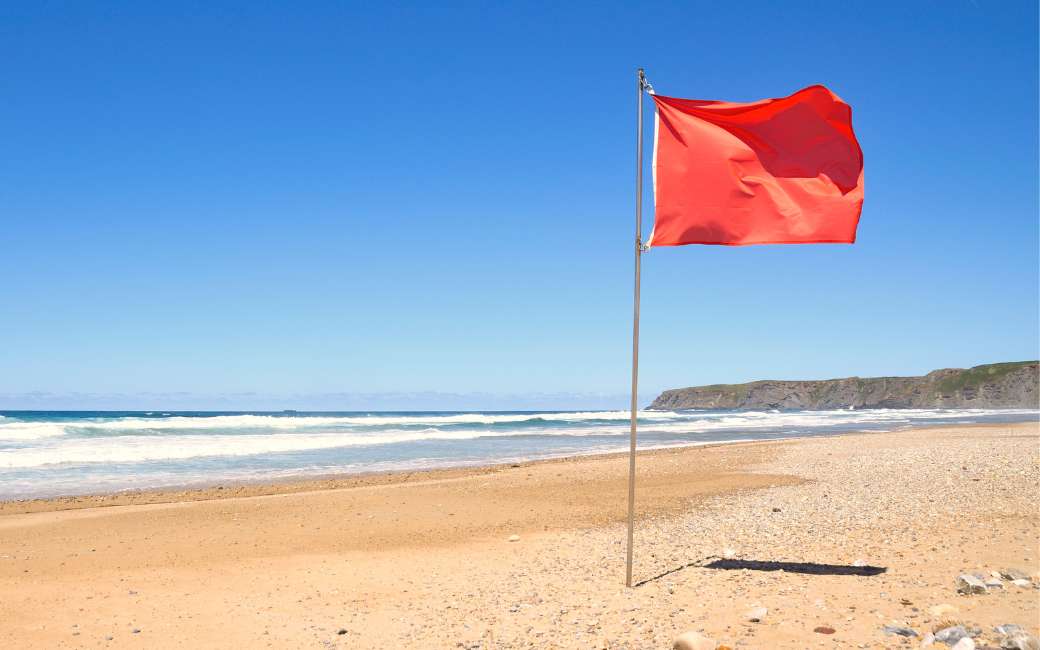In recent weeks, many sharks have been seen off the Spanish coast. This causes some concern to many beach visitors, although it is known that the sharks that have been sighted, the “great blue shark” or “tintorera” in Spanish, are not dangerous to humans. But how do you know that sharks are in the sea? Look for the colorful flags of the rescuers.
If a shark is seen, everyone is pulled out of the sea first, so if everyone is on the beach and no one is swimming in the sea, you already know something is up. You can also see from the red flag that it is forbidden to enter the sea. Spain, unlike the presence of jellyfish, does not have a special flag for sharks. This is why the red flag is simply raised.
But what do the colors of the flags on Spanish beaches mean? We explain it in this article so that you can go on vacation well prepared.
blue flag
The first flag we deal with has nothing to do with safety, but with the quality of the beach. The blue flag (bandera azul) is awarded annually to those beaches that meet the quality requirements.
green flag
When the lifeguards raise the green flag (bandera verde), there is nothing wrong, the sea is calm and it is safe to swim in it. Fortunately, the green flag is the most common flag on Spanish beaches, which means that it is generally safer than entering the unsafe sea.
yellow flag
When the yellow flag (bandera amarilla) is hung, it means that it is dangerous to swim in the sea. Floating objects are prohibited at that time. This yellow flag is often raised when there is a wild sea with waves that can be seen by beachgoers or below a wild surface that cannot be seen with the naked eye.
The yellow flag does not mean that it is forbidden to swim, but one must be careful. In principle, in Spain it is said that you can only swim with the yellow flag in that part of the sea where you cannot walk further until your head is hidden under the water.
red flag
When the red flag (bandera roja) is hung, it is forbidden to enter the sea. Swimming in the sea can be dangerous and can put lives in danger. The red flag is hung when there are many waves and rough seas, when there is a lot of groundwater, after a storm, pollution, or the presence of dangerous animals such as sharks, jellyfish, etc.
There is also a red flag with jellyfish graphics, which means that there are many jellyfish in the sea and it is forbidden to swim, as is the Portuguese man-of-war. However, there is also a white jellyfish flag where swimming is still allowed.
In many municipalities in Spain, people who go to the sea with a red flag can be fined for irresponsible behaviour. Fines can be €1,000 or more, depending on municipal law.
black flag
Fortunately, you don’t see the Black Flag (Bandera Negra) much in Spain because that means it’s extremely dangerous to swim there. The beach is closed at that time due to problems such as pollution on the beach itself or in the sea. Black flags are also awarded annually in Spain, as an analogue to the blue flags.
orange flag
The orange flag (bandera naranja) is there, but fortunately you don’t see it often. If this flag hangs, it means that the savior (socorrista) is absent and not in place.
White flag with jellyfish
If a white flag with jellyfish (bandera medusas) is hung, this means that jellyfish have been seen in the sea. Swimming is not prohibited, but swimmers should be careful as they can be stung by jellyfish. So swimming with the white jellyfish flag is still allowed but if the jellyfish flag is colored red, swimming in the sea is prohibited due to the presence of dangerous jellyfish like the Portuguese man of war.
Mark with a “Q”
A flag with the letter “Q” on it has nothing to do with a dangerous situation on the beach or in the sea, but rather indicates that the beach is of excellent quality. The “Q” stands for “Calidad Turística”, a stamp issued by the Calidad Turística Española (ICTE) for beaches, hotels, establishments, marinas, etc.

“Creator. Award-winning problem solver. Music evangelist. Incurable introvert.”







More Stories
British military spy satellite launched – Business AM
Alarming decline in the Caspian Sea
Lithuania begins construction of military base for German forces